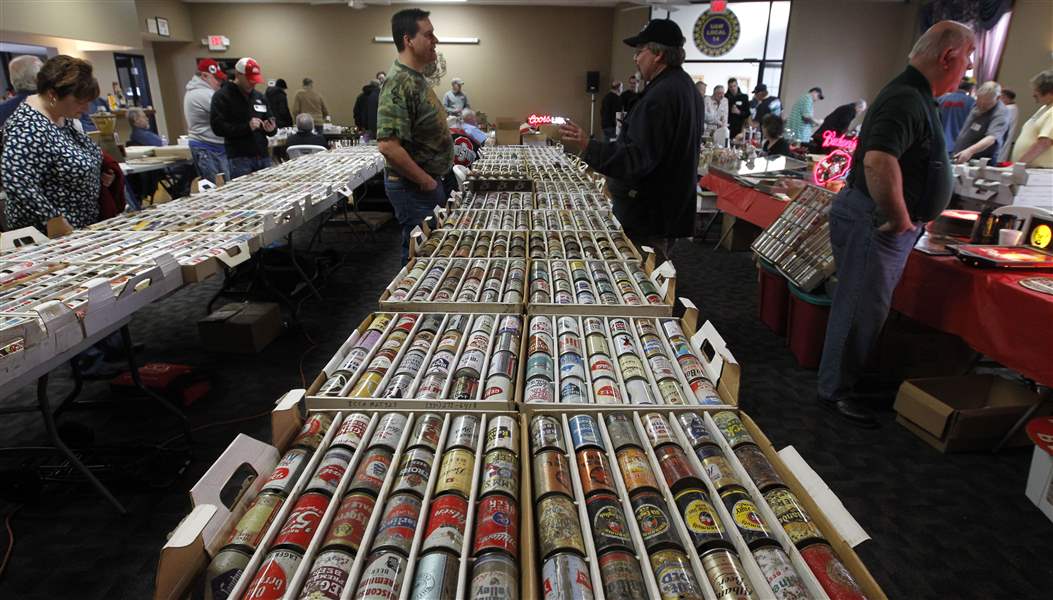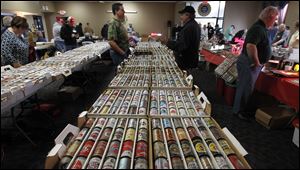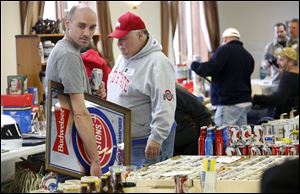
Hobby of collecting beer cans continues to grow
3/16/2014
Rob Reichenbach, center left in camo shirt, speaks to a potential customer during the 40th Annual Buckeye Beer and Mancave Show at the UAW Hall in Toledo. Reichenbach, who brought 2,000 of his 35,000 beer cans to trade and sell, said he has been to this show 29 times.
The Blade/Lori King
Buy This Image

Rob Reichenbach, center left in camo shirt, speaks to a potential customer during the 40th Annual Buckeye Beer and Mancave Show at the UAW Hall in Toledo. Reichenbach, who brought 2,000 of his 35,000 beer cans to trade and sell, said he has been to this show 29 times.
Breweriana, not a state but perhaps a state of mind, is enjoying an uptick in popularity.
“There’s a lot of new people collecting,” said John Huff, president of the Toledo Buckeye Chapter of the Brewery Collectibles Club of America. He cites the popularity of man caves, as well as the emergence of microbreweries and craft beers that often sport clever names and labels.
About 500 collectors of beer cans, serving trays, neon signs, and more shopped and swapped from 150 vendors March 8 at the 40th annual Beer Collectible Show at Local 14 UAW Hall on Jackman Road, organized by the 50-member Toledo club. Collectors are mostly men, averaging 50 to 55, said Mr. Huff.
“It’s a hobby, like stamps or coins. A nice thing about this is you can always crack a beer and discuss with your friends what you’re doing,” he said.
PHOTO GALLERY: View more photos of collectibles and collectors
Marc Monroe, who once shared a collection of more than 12,000 cans with his father, Don Monroe, knows cans.
It started when he was 9: riding his bike, a colorful Schlitz Malt Liquor can on the ground caught his eye. He took it home. He found an Olde English 800 and a Robin Hood can and pretty soon he had a stacked pyramid in the basement. At 12, his father took him to the Buckeye Beer Collectibles Show and Don, a well-known Toledo leader, was collecting Buckeye Beer paraphernalia.
“At the time, beer collecting was one of the fastest-growing hobbies,” said Marc Monroe, of West Toledo. He specializes in U.S. cans made between 1935 and the pre-pull tab early 1960s.
Prices, he said, are driven by scarcity, how long a brewery existed, and supply and demand, and online sales can be brisk.
Contact Tahree Lane at tlane@theblade.com or 419-724-6075.

Monroe, Mich. resident Jay Heinzerling carries around a Budweiser Pistons mirror to trade or sell during the 40th Annual Buckeye Beer and Mancave Show at the UAW Hall in Toledo.
Breweriana trivia to whet your whistle
● Toledo has had at least 18 breweries, beginning in 1838 with what would be bought several times and was best known as Buckeye Brewing Co. It also produced Green Seal beer.
● Beer was bottled until the first beer can was produced by Krueger Brewing Co. in 1935 shortly after Prohibition’s 1933 end (it had lasted 13 years). It was a flat top, made of steel with a protective liner to prevent beer from acquiring a tinny taste. Other breweries quickly followed suit. Steel is more durable than glass and easier to package and ship.
● The beer can required an opening tool. Commonly called a church key, it had a sharp pointed end to pierce two triangles in the top, one for drinking, the other for air to improve flow. The tool’s other end was often a rounded opener for pulling off metal bottle caps.
● Cone tops, also steel with a round cap that required an opener, were introduced about six months later. Its small, elevated spout replicated the sensation of drinking out of a bottle.
● Because steel was needed by the U.S. military during World War II, the only metal beer cans made in 1943 were olive-drab and exported to troops. Camouflaging the cans eliminated the chance that an enemy plane would notice the glint of a steel can below.
● The Holy Grail of cans, going for as much as $50,000, are Tiger Beer (only one is known to exist) and Rosalie Beer (two are known).
● Pull-tab tops were introduced in the early 1960s. Many people suffered cuts and nicks until designs were improved.
● Today’s 12-ounce beer cans are the same height as in 1935: 4¾ inches.